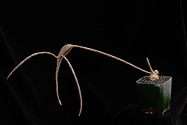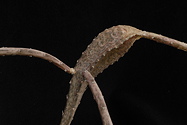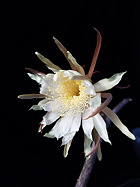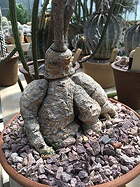This species was originally described as Peniocereus rosei in 1926 and only recently (2013) transferred to Acanthocereus by Joel Lodé. DNA work by Salvador Arias et al. (Journal of Plant Research 118:317-328, 2005) supports a more restricted concept of Peniocereus, while other species formerly in that genus better fit in Acanthocereus. However, the authors left the recombinations to others. The two genera differ in Peniocereus having monomorphic stems, i.e. juveniles and adults are identical, while Acanthocereus can have strikingly dimorphic stems, three-angled in juvenile growth and cylindrical when mature. Both genera have scrambling stems, sometimes climbing into the surrounding vegetation. The mature stems of A. rosei are long, slender, pencil-thick and pink-mottled, arising from thick tuberous roots characteristic of the genus. The temptation to raise these as a caudex has led us to experiment. This results in some shriveling of the tubers which seem to be designed to live underground. However, some growers have succeeded in preventing premature wrinkles by shading the caudex with sphagnum moss when not being exhibited. We offer rooted cuts of HBG 23201, a plant originally collected by Myron Kimnach (238), July 15, 1962, in shady forest, 18.5 mi E of Coyotitan, along the road to San Ignacio, Sinaloa, Mexico. $7.

Published in the Cactus and Succulent Journal, Vol. 91 (2), Summer 2019




